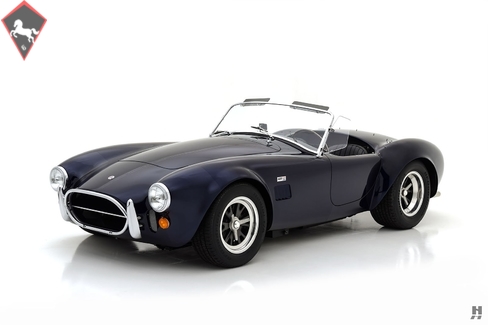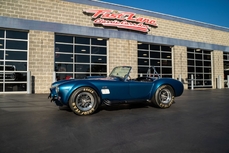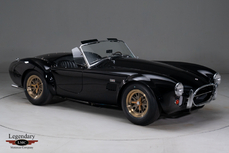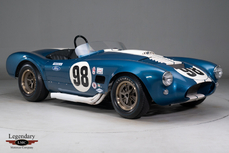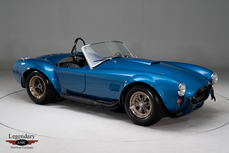Shelby Cobra 427 Cobra Roadster 1967
General description :
From day one, racing played a vital role in the Shelby Cobra’s development. The small-block Shelby Cobra (AC Cobra in the UK) was an instant sensation on the street and the race track, with the agile little roadsters handily showing the new Corvette Stingray a clean pair of heels in SCCA competition. By the mid-1960s, Shelby was racing the Cobra roadster and special-bodied Daytona Coupe on the world stage, taking on the might of Ferrari in the GT class and coming out on top for the 1965 season. All along, however, the quest for more power weighed heavily on the minds of Carroll Shelby and his right-hand man, Ken Miles. By 1963/1964, the 289 was at the peak of its development, maxing out at 385 reliable horsepower and stay at the sharp end of the field, they knew the Cobra needed a lot more grunt.
Following an uncharacteristic embarrassment at the hands of the Grand Sport Corvettes during the 1963 Nassau Speed Week, Ken Miles retreated to the drawing board. A past drive in a 427-powered NASCAR Galaxie left a deep impression on Miles, and he felt the big-block would be the perfect fit for the lightweight Cobra. A hastily built prototype using 289 suspension was tested at Sebring, and despite woeful handling, it proved to be blisteringly fast in a straight line. Its performance was enough to convince Shelby, Miles, and Ford that the 427 would power the next generation Cobra. A great deal of development followed as the Cobra chassis was wholly reworked to handle the additional weight and power of the big Ford V8. Ford offered the services of its chassis engineers to assist Miles, with the only restriction being the 90-inch wheelbase which formed the basis for all of AC’s body jigs. Chassis tube diameter increased to 4-inches, and the antiquated leaf-spring arrangement tossed out in favor of an all-new fully adjustable coil-spring setup at all four corners. The body was heavily reworked with dramatic flared wheel arches to accommodate the fat rubber required to put the power to the ground. With the new chassis, the 427 Cobra delivered handling that rivaled the small block 289, coupled with astonishing straight-line performance. For decades to come, few cars could touch the 427 Cobra for its near-mythical performance. Even today, the 427 Cobra counts among the greatest sports cars ever built, and they enjoy permanent standing as true automotive icons.
Our featured Cobra is CSX 3341, one of only 343 genuine coil-spring, big-block Cobras produced. A very late production example, this car is among the last 20 cars built by Shelby, and it presents in stunning condition, with a recently-completed restoration by noted Cobra expert Mike McCluskey. The history of this particular chassis is well-documented by the Shelby American Automobile Club. It was sold new to Richard Darnell of South Bend, Indiana by Romy Hammes Ford (also of South Bend) in July of 1967. SAAC registry information lists the original color as Rangoon Red over a black interior, and equipped with a 427 engine with dual-quad intake. After just one year and 1900 miles, Darnell listed the car for sale. A series of owners followed, with documents noting its appearance at the 2nd annual SAAC convention held in Hershey, Pennsylvania in 1977. There, it was recorded to show 30,000 miles, fitted with sunburst wheels, under-car exhaust exiting ahead of the rear wheels, and dark jade green paintwork. By the mid-1980s, it reappeared finished in Rangoon Red and with a correct-type replacement 427 engine built by noted Ford guru Jack Roush. In the early 1990s, it had passed through the hands of Mike McCluskey for the first time, where it received several updates including side exhaust, S/C wheel arch lips, and a hood scoop. Eric Bernhard of Entropy Racing installed a factory style 3-point roll bar and updated the suspension and brakes for vintage racing. At that point, the car was repainted in Viking Blue with white stripes. In this configuration, the car raced extensively on the West Coast, appearing multiple times at the Monterey Historics and the Wine Country Classic at Sonoma Raceway throughout the 1990s and early 2000s.
The current owner acquired the car from Gary Hunter in approximately 2011. In 2016 he commissioned Mike McCluskey to perform a complete, concours quality restoration and return the car to street specification. Still appearing very fresh, CSX 3341 is an absolutely exquisite example. Mr. McCluskey noted that while some minor chassis tubes were replaced over time, neither body nor chassis showed evidence of crash damage or severe corrosion. His team took great care to preserve the originality while returning the car to its factory street spec. It now presents in absolutely gorgeous condition, with correct under-car exhaust, proper street-spec wide-hip wheel arches, and no roll bar. The dark midnight blue paintwork and unadorned street trim accentuate the beautiful lines, and the quality of the finish is outstanding, with impeccable panel fit and detailing. Like the exterior bodywork, the inner panels are restored to exacting standards, with new foot boxes, inner trunk panels, and fender wells all appearing correct and beautifully finished. The process of the restoration is well-documented in a series of photographs.
Purposeful and straightforward, the two-seat cockpit is all about the business of handling the mighty 427 with no distractions. Once aboard, the seats are quite comfortable, and the controls fall easily to hand. The soft trim consists of period-correct leather, vinyl, and carpet, all in black as original. Smiths instruments are fully restored, and the wheel and shift lever are proper 427 items. Like the body, the interior restoration is impeccably detailed and executed to a very high standard.
Under the bonnet sits the heart and soul of the Cobra legend – Ford’s mighty 427 cubic inch V8. Like the rest of the car, the engine is highly detailed, with an authentic presentation. As part of the restoration, the engine was stripped down, sonic checked, and completely rebuilt with a balanced rotating assembly. Fed by a single 4-bbl carburetor, it runs strong and delivers the kind of breathtaking performance one expects from a big-block Cobra. Information from both the restorer and The Cobra Registry points to CSX 3341 being a cherished car for its entire life. Evidence shows it was never wrecked, neglected or cut up, and the few modifications it did receive to go racing were done so without sacrificing the car’s highly original character. Now fresh from a world-class restoration and equally suited to concours and road events, CSX 3341 will surely impress the most discerning enthusiast.
https://hymanltd.com/vehicles/6423
1967 Shelby Cobra 427 Cobra Roadster is listed sold on ClassicDigest in St. Louis by Mark Hyman for $1300000.
Car Facts
Car type : Car Make : Shelby Model : Cobra 427 Model Version : Cobra Roadster Engine size : 0.0 Model Year : 1967 Sub type : Convertible Location : Missouri
Sold
Seller Information
Sold
People who viewed this Shelby Cobra 427 also viewed similar Shelby listed at ClassicDigest
Other cars listed for sale by this dealer
About Shelby
Carroll Shelby, a legendary figure in the automotive world, had a remarkable journey from being a successful race car driver to becoming a renowned sports car manufacturer in the United States. His story is filled with achievements, innovations, and iconic cars that left an indelible mark on the industry.Early Years and Racing Career:
Carroll Shelby was born in 1923 in Texas. He initially pursued a career as a pilot during World War II but found his true passion in racing after the war. Shelby became a successful race car driver in the 1950s, competing in various events including Formula One, endurance racing, and the famous 24 Hours of Le Mans.
Shelby Cobras - Iconic Sports Cars:
Carroll Shelby's pivotal moment as a manufacturer came with the creation of the Shelby Cobra, an iconic American sports car. The Cobra was born from the fusion of a British AC Ace chassis and a Ford V8 engine, creating a lightweight, high-performance car that dominated tracks and streets alike. Key models include:
Shelby Cobra 260 (1962): The initial version with a 260 cubic inch (4.2L) V8 engine.
Shelby Cobra 289 (1963-1965): Later iterations with a 289 cubic inch (4.7L) V8 engine, including the competition-spec Cobras known for their racing prowess.
Shelby Cobra 427 (1965-1967): The most powerful iteration with a 427 cubic inch (7.0L) V8 engine, known for its raw power and performance.
Ford Partnership - Shelby Mustangs:
Shelby's partnership with Ford led to the creation of legendary Shelby Mustangs. The most notable model is:
Shelby GT350 (1965-1969): Based on the Ford Mustang, the GT350 was modified by Shelby American, featuring enhanced performance, handling, and distinct styling.
Other Notable Models and Achievements:
Beyond the Cobras and Mustangs, Shelby had several other significant contributions:
Shelby Daytona Coupe: Created to win against Ferrari in international GT racing, this car became the first American car to win the FIA GT World Championship in 1965.
Shelby Series 1: Introduced in the late 1990s, this was Shelby's modern take on a high-performance sports car.
Ford GT40 plays a pivotal role in Carroll Shelby's narrative, especially in his connection to Ford and his significant contribution to the car's success.
The Ford GT40 Development:
Ford's Challenge:
In the early 1960s, Henry Ford II sought to acquire Ferrari, but negotiations fell apart. This spurred Ford's determination to beat Ferrari at the prestigious 24 Hours of Le Mans endurance race, which Ferrari had dominated for several years.
Collaboration with Shelby:
Ford turned to Carroll Shelby, recognizing his racing expertise and track record. Shelby was tasked with leading the GT40 project and turning it into a competitive race car capable of challenging Ferrari's supremacy.
Development and Triumph:
Under Shelby's guidance, the Ford GT40 underwent rigorous development to address initial design flaws and performance issues. Several iterations were produced:
Early Attempts: The initial versions of the GT40 faced reliability and handling issues, leading to disappointing results at Le Mans in 1964.
GT40 Mark II: Shelby's team made crucial improvements. The Mark II, equipped with a powerful V8 engine, improved aerodynamics, and refined engineering, became highly competitive.
Le Mans Victory:
In 1966, the Ford GT40 Mark II achieved a historic victory at the 24 Hours of Le Mans, with Shelby-coached driver Ken Miles leading the race. This marked the first win for an American manufacturer at Le Mans, breaking Ferrari's dominance.
Continued Success:
The GT40 continued to dominate, winning Le Mans for the following three years (1966-1969), securing its place in racing history and solidifying Ford's reputation as a force in international motorsport.
Shelby's Contribution to the GT40 Success:
While Carroll Shelby wasn't directly involved in designing the GT40, his expertise in racing and his ability to assemble and lead a team of talented engineers, mechanics, and drivers were instrumental in refining the car's performance. His influence helped address technical issues, refine the car's handling, and strategize race tactics, contributing significantly to the GT40's success on the track.
Legacy and Impact:
The Ford GT40's victories at Le Mans under Shelby's guidance remain one of the most iconic achievements in motorsport history. The car's success solidified Shelby's reputation as an automotive visionary and further strengthened his partnership with Ford.
Carroll Shelby's involvement in the GT40 project showcased his ability to transform a struggling project into a championship-winning machine, adding another remarkable chapter to his illustrious career in the automotive world.
